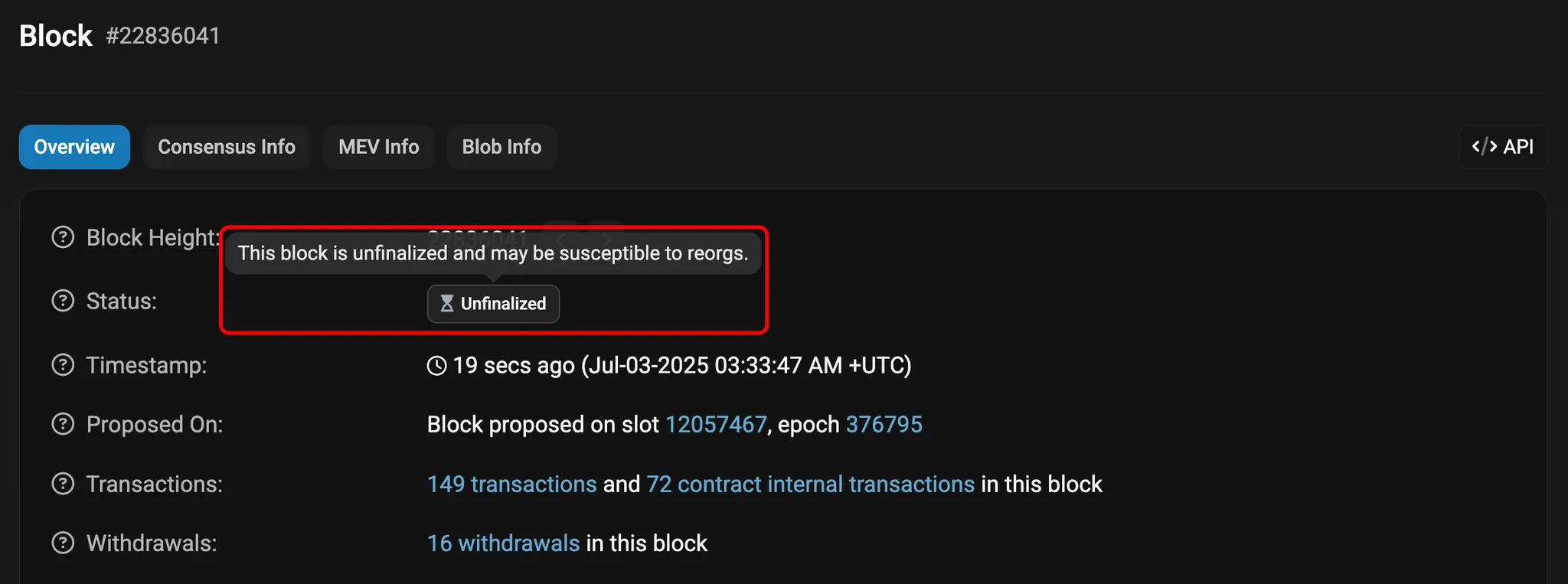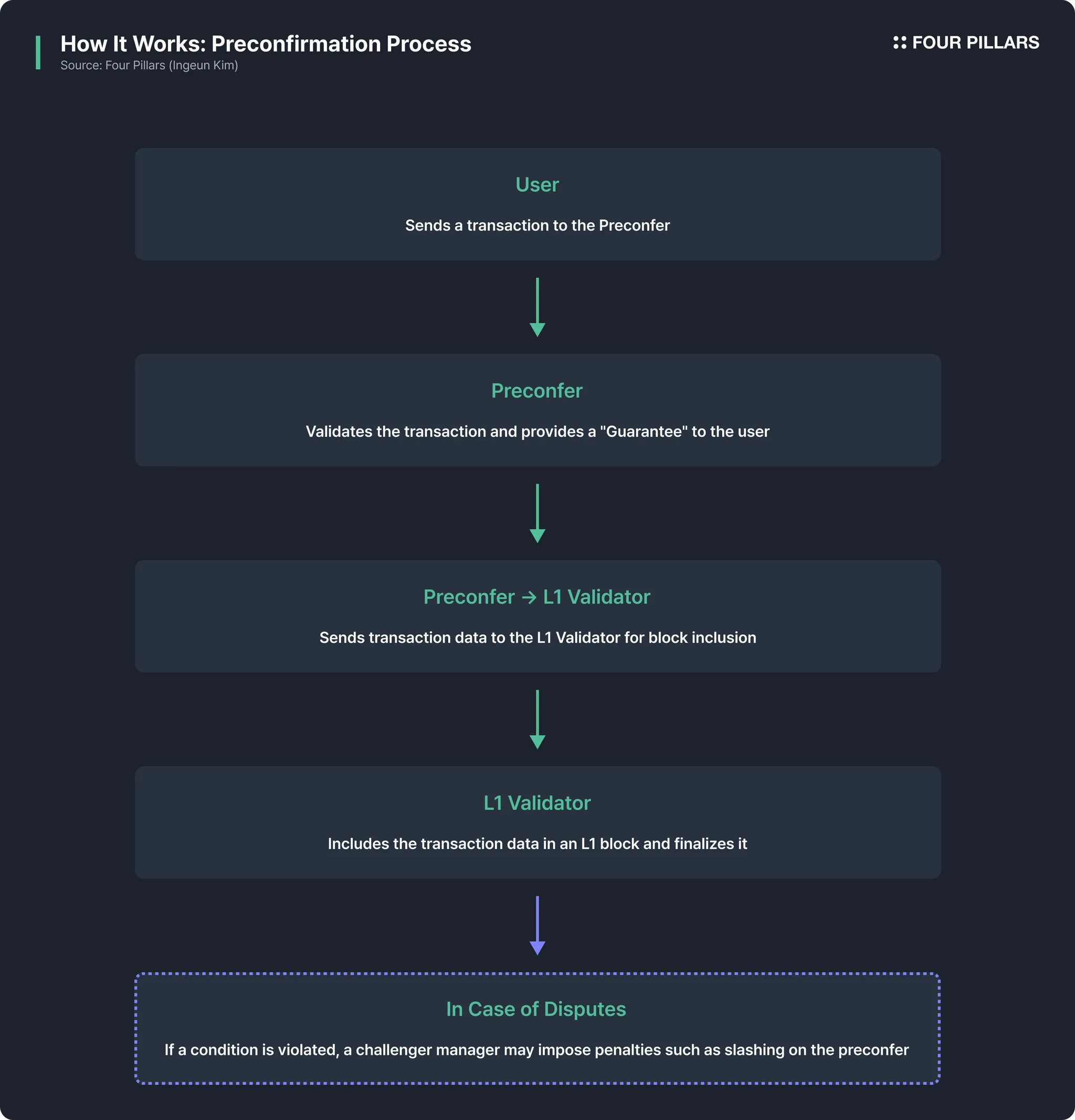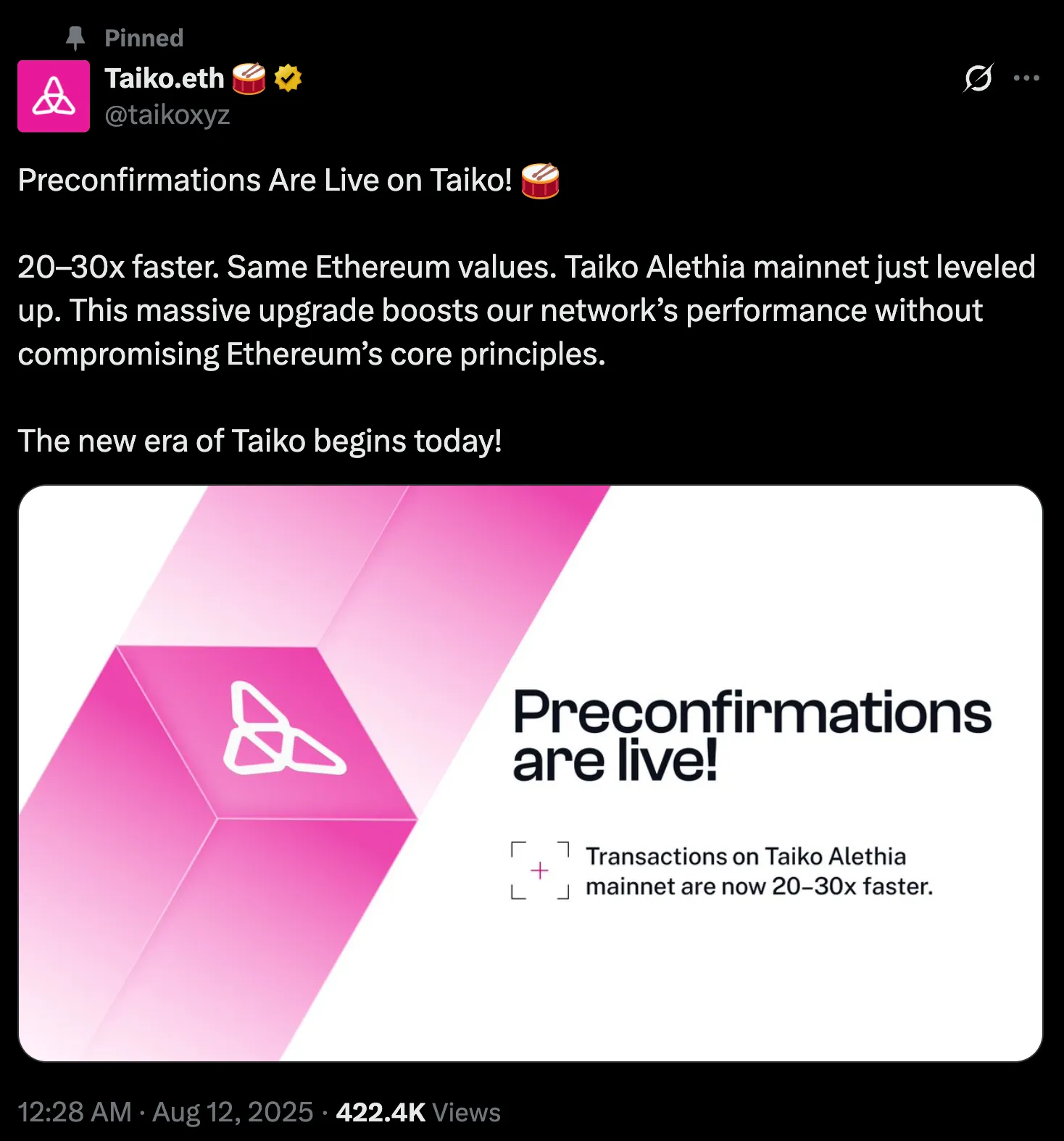Preconfirmation is a technology that quickly provides users with a guarantee that their transaction will soon be processed once it has been sent. By offering this guarantee before rollup data is posted on the L1 chain, it establishes trust. This allows blockchain to deliver an instant user experience similar to credit cards, with the core of this experience being the Preconfer, which guarantees transaction execution.
The Preconfer is responsible for including the user’s guaranteed transaction in a block and, in return, earns economic incentives through fees and additional MEV revenue. However, if only a small number of entities take on the role of Preconfer, centralization risks arise, such as censorship, unfair competition, and undermining trust neutrality. To address this, a decentralized Preconfer model based on collateral and slashing is required.
Taiko recently introduced preconfirmation functionality on its mainnet “Alethia” and began live operations. Initially, for stability, it chose a centralized model using a whitelist approach. However, in the future, it plans to transition to a permissionless structure open to anyone, as a strategic move to both improve user experience and uphold the philosophy of blockchain.

Source: Unsplash
There’s something we all experience in daily life. When we buy coffee at a café and swipe a credit card, the POS terminal or kiosk screen flashes “Approved” or “Payment Complete.” At that moment, we feel the payment is done, and in our mind, the thought “the money has gone” naturally pops up. But in reality, the money has not actually moved in real time.
The true settlement only completes after several days of reconciliation. The card transaction data travels between the merchant, the issuing bank, and the payment networks (Visa, Mastercard, etc.). During this process, refunds, cancellations, or disputes can occur, and sometimes transactions are invalidated retroactively. In other words, the transaction isn’t fully finalized yet. Still, we walk away with our coffee without a second thought. Why?
Because the credit card system takes on the uncertainty of settlement on behalf of the consumer. Payment networks like Visa and Mastercard provide psychological assurance by instantly showing an approval message. If issues arise later, the burden is shared among merchants, issuing banks, and networks under contracts and rules. That’s why consumers rarely feel the complexity of what happens behind the scenes.
In this way, the credit card system distributes the risks of settlement across the stakeholders (merchant, issuer, network), not the consumer. The “Payment Complete” we see is essentially a form of engineered pseudo real-time. Actual settlement and finality come days later, but the waiting is absorbed by the system, not the user. The result: dramatically better usability and a smoother payment experience.
Blockchain, however, has struggled to replicate this structure. The reason lies in its fundamental philosophy. Blockchains are designed for security in trustless environments. There are no intermediaries, no off-chain promises. Only transactions and blocks that reach consensus are recognized as truth.

Source: Etherscan
Take Ethereum, for example. When a user sends a transaction, it must be included in one of the blocks, which are produced roughly every 12 seconds. Even then, to be considered “irreversible,” additional subsequent blocks must be added on top. Typically, that means waiting for 12–64 blocks, anywhere from a few minutes to over ten.
Ethereum rollups emerged to mitigate this, processing transactions on Layer 2 before batching and settling them on Layer 1. This reduced fees and improved throughput significantly. But in terms of settlement finality, not much changed.
Even if a rollup confirms transactions quickly on its own chain, true settlement and finality still depend on Ethereum L1. Until the batch is posted and finalized on mainnet, users can’t be fully sure their transaction “really counts.” This lack of instant assurance leads to weaker psychological trust and creates a sense of “incomplete service” for users.
This is where preconfirmation enters. Preconfirmation adds an immediate psychological guarantee on top of blockchain’s slow finality. It begins from the insight that not all users need L1-level finality every time. What most users want is a credible guarantee that “this transaction will go through.” Preconfirmation provides exactly that inside the blockchain system.

Here’s how it works: when a user submits a transaction, a special participant in the network called a preconfer reviews it and returns a signed guarantee that it will be included in their proposed block. This guarantee is essentially a promise. If the promise is broken, the preconfer suffers penalties, so it carries weight beyond just a signature.
The biggest strength of this structure is speed. While an L1 block may take seconds or minutes to be produced and finalized, preconfirmation can give feedback within ~100ms that a transaction is secured. This is much closer to the “approved” message from credit cards, enabling blockchain to deliver a user experience on par with traditional finance for the first time.
At the heart of all this is the preconfer. They are not just relay nodes but participants with block proposal rights under Ethereum’s proposer-builder separation (PBS). With both the authority and accountability to keep their promises, the system’s trust ultimately derives from the responsibility of the preconfer.
A preconfer is the entity that issues cryptographic promises backed by economic guarantees to users, serving as the central actor in the preconfirmation system. Their essential role is to bridge the time gap between transaction submission and block finality. The preconfer’s operational workflow consists of several steps:

The user submits a transaction to the preconfer. At this stage, the transaction has not yet been included on-chain. The preconfer receives the request and prepares to review it.
After validating the transaction, the preconfer sends back a guarantee. This is a signed certificate promising that the transaction will be included in an L1 block. The user thus gains quick confidence in its finality.
To actually include the transaction on-chain, the preconfer forwards the data to an L1 validator. If the preconfer also acts as a block builder or proposer, they can directly include the transaction in their own block. Otherwise, in a PBS (Proposer-Builder Separation) environment, they must rely on a trusted block builder to include it.
The L1 validator includes the transaction in a block and finalizes it on-chain. The user’s request now reaches full on-chain settlement, and the preconfer’s promise is fulfilled as true finality.
If the preconfer fails to uphold the guarantee—by omitting a promised transaction or issuing conflicting guarantees—they face penalties such as slashing. These sanctions enforce responsible behavior and uphold system-wide trust.
Becoming a preconfer can be technically demanding. To properly assess both L1 and L2 state and validate transactions, operators must run highly available, high-bandwidth full nodes. This makes the role more suited to specialized, well-capitalized operators than to casual participants.
Why would an operator invest such technical expertise and capital to act as a preconfer? The answer lies in economic incentives. The most direct incentive is the fee (tip) paid by users for the preconfirmation service. Users willingly pay for instant confidence and smoother UX, creating a new revenue stream for validators beyond block rewards and MEV (Maximal Extractable Value).
Preconfirmation also intersects deeply with MEV. By controlling a set of preconfirmed transactions, preconfers can either construct more valuable blocks themselves or sell blockspace to professional builders for profit. For example, Puffer’s AVS model includes an MEV-smoothing mechanism that averages fees across time and validators, reducing volatility and making validator income more predictable.
Over time, validators offering preconfirmation services can achieve higher overall returns, making them more attractive to stakers and delegators. This positions preconfirmation as a new differentiator in the staking services market, shifting validators from passive block signers focused only on L1 security to active participants generating additional yield.
Moreover, to provide preconfirmation, L1 validators must run L2 full nodes and sell “fast finality services” to L2 users. This means validator revenues will increasingly depend on the economic activity of the L2s they serve, creating a strong incentive for validators to actively support thriving L2 ecosystems. This forms a positive feedback loop between L1 security and L2 growth.
As preconfers become indispensable infrastructure for preconfirmation, critical questions emerge: Who can become a preconfer? How are they selected and operated? Currently, two main models exist: whitelist-based centralized systems and slashing-based permissionless decentralized systems.
Whitelist-based centralized models restrict the role to a small set of pre-approved operators, often chosen by a DAO or a core team. For example, Espresso Systems runs a BFT-based shared sequencer with its own validator set, while Astria uses its PoS blockchain to assign sequencer roles selectively. Such centralized models provide quality and performance control in early stages, but suffer from limited openness and opaque governance.
Slashing-based permissionless decentralized models, on the other hand, allow anyone to participate as a preconfer by staking collateral. Misbehavior triggers automated slashing, enforcing trust. Puffer Finance’s UniFi implements this model on its AVS infrastructure, pairing it with MEV-smoothing for sustainable and transparent rewards. Similarly, Chainbound (BOLT) integrates with decentralized infra like MEV-Boost, EigenCloud (formerly EigenLayer), and Symbiotic, opening the preconfer market through restaking collateral.
The choice of model profoundly affects the system:
Concentrated authority undermines credible neutrality. Since preconfers influence transaction ordering and block construction, monopolization risks fairness and neutrality.
Opaque criteria and governance can erode community trust if the process of operator selection is unclear.
Monopolization of economic opportunities (MEV revenue, user tips) distorts competition, potentially raising costs and lowering service quality.
Centralized censorship risk arises if a small set of preconfers can block or delay certain transactions.
For these reasons, sustainability and trustworthiness of the preconfirmation ecosystem require moving beyond temporary centralized whitelists to permissionless, collateral-backed decentralized models. Slashing-based systems combine open participation with strong deterrence against malicious behavior, aligning incentives for reliability and fairness.
Taiko has drawn attention for being one of the first to introduce preconfirmation into a live network and for laying out a clear roadmap toward decentralizing preconfers.

Source: Taiko X
Taiko has already integrated preconfirmation into its testnet Hekla, achieving ~2-second fast finality with the Pacaya upgrade. More recently, Taiko extended this feature to its mainnet Alethia, preparing to offer all users millisecond-level transaction confirmation experiences.
Currently, however, the system runs on a whitelist-based centralized preconfer model. As noted earlier, this approach has inherent limitations in openness and credible neutrality, making it unsustainable as a long-term solution.
With this in mind, Taiko has set a clear goal: gradually decentralize the preconfer system. The plan is to start with a centralized whitelist model, then progressively transition to a slashing-based, permissionless model. This reduces entry barriers to becoming a preconfer and shifts trust enforcement from central actors to collateral and crypto-economic incentives.
The most important reason Taiko opted for a staged approach—from centralized to decentralized preconfers—is risk management. Launching a complex permissionless economic system from day one could expose the network to unpredictable risks. Starting with a whitelist of trusted, technically vetted operators acts like “training wheels,” allowing Taiko to deliver immediate UX benefits while controlling risks such as bugs, economic exploits, or network instability.
Another reason is bootstrapping stability. In the early stages of a network, providing users with consistent and predictable experiences is paramount. Whitelisted preconfers can guarantee stable service—such as the 2-second block time target—while an open system of random, permissionless sequencers might lead to inconsistent UX.
Lastly, the whitelist phase gives Taiko valuable opportunities to collect real-world data in a controlled environment. This includes performance metrics, network load, economic dynamics, fee markets, interactions with PBS pipelines, and potential attack vectors. Such data helps refine slashing mechanisms and parameter settings, ensuring that when the decentralized model launches, it is robust and well-calibrated.
If Taiko successfully transitions to a decentralized preconfer model, several benefits can be expected:
True Decentralization and Credible Neutrality: A permissionless, slashing-based model prevents any single entity from controlling preconfer participation. This removes central points of failure and censorship risks, ensuring neutrality is enforced by collateral-backed crypto-economics rather than reputation or trust.
Competitive Market Formation: An open system fosters healthy competition among preconfers. They will compete on lower fees, faster confirmation times, and higher reliability. Users naturally benefit from better services, creating a far more efficient market than a small whitelist of operators could provide. Over time, this enhances the overall efficiency of the ecosystem.
Strengthened Economic Ties with Ethereum (L1): By allowing any Ethereum validator to leverage their infrastructure to serve as a preconfer on L2 and earn extra revenue, Taiko increases validator profitability. This strengthens Ethereum’s economic security, creating a positive feedback loop: Taiko’s adoption directly contributes to Ethereum’s sustainability and resilience.
In short, Taiko’s phased strategy balances safety and pragmatism in the short term while paving the way for a fully decentralized, permissionless, and economically aligned preconfirmation ecosystem in the long run.
Preconfirmation is emerging as a breakthrough technology that dramatically improves L2 user experience by providing millisecond-level rapid finality. Through the cryptographic guarantees issued by preconfers—the central actors in this system—users gain near-instant confidence that their transaction will be finalized. At the same time, preconfers unlock new economic opportunities by earning fees and MEV revenue from users. This shift is redefining the role of L1 validators: from passive block producers to active infrastructure providers generating profits. Preconfers now stand at the center of both technical and economic transformation.

Source: imgflip.com
Yet, as the value of preconfirmation grows, so too do the power and responsibilities concentrated in the hands of preconfers. They are not mere intermediaries but entities that guarantee transactions and are held accountable for them. As their economic rewards increase, the risks of centralization become more pronounced. In particular, some projects restrict preconfer roles to a small set of whitelisted operators. While this can help ensure stability during early stages, it ultimately risks undermining blockchain’s philosophical foundation of permissionlessness and decentralization.
Against this backdrop, decentralizing the preconfer role is no longer optional but essential. Nonetheless, the current preconfirmation community tends to focus more on technical completeness and economic design, often neglecting the importance of decentralization.
In this context, Taiko initially adopted a whitelist-based centralized preconfer model but has laid out a clear roadmap to transition toward a slashing-based, permissionless model, where anyone can participate by posting collateral. Now that preconfirmation is entering real-world deployment, Taiko’s phased approach provides a benchmark for how this technology can scale and mature. Whether blockchain can uphold both user-friendliness and philosophical consistency depends on who operates preconfirmation and how it is structured.
Looking ahead, projects building within the preconfirmation ecosystem should closely monitor how Taiko executes its decentralization roadmap. Based on those lessons, it is time to collaboratively design a more open and sustainable preconfirmation model for the future.
Related Articles, News, Tweets etc. :
Dive into 'Narratives' that will be important in the next year